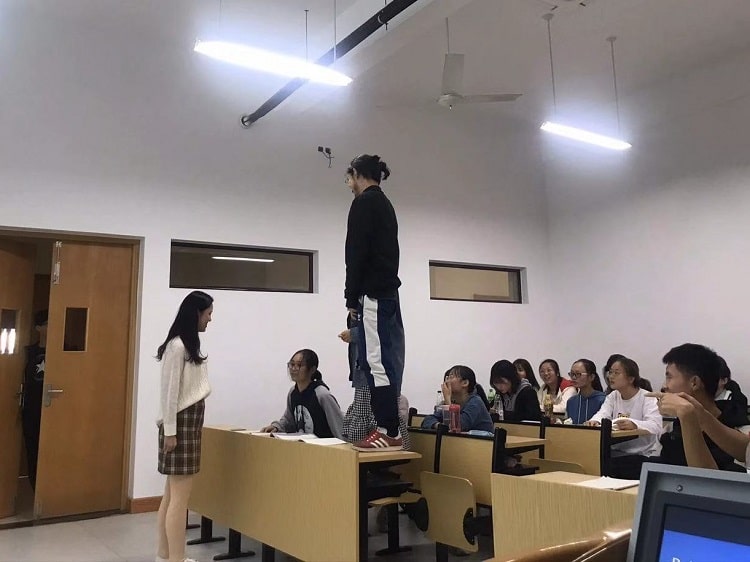Have you ever wondered what it’s like teaching IELTS courses in China?
As an increasing number of Chinese students now aspire to study, travel or work abroad, the demand for teachers who are able to teach this course is on the rise.
What is IELTS?
IELTS stands for ‘International English Language Testing System’.
It’s designed to help those who wish to work, study or migrate to a country where English is the native language, such as the UK, US, or Australia.
IELTS assesses a candidate’s ability to listen, read, write and speak in English. Many Chinese students aspire to study or travel abroad, especially in the USA, so the ability to teach this course is a skill that’s increasingly being demanded of foreign university teachers in China.
My experience teaching IELTS courses in China
The first time that I was assigned to teach an IELTS course in China was in the autumn semester of 2019.
To be honest, I freaked out because teaching an IELTS course is quite a niche area which neither my China TEFL course nor my CELTA course really prepared me for.
To be a proper IELTS teacher, strictly speaking CELTA or TEFL-qualified teachers would need to undertake further training of at least 60 hours duration.
One such course, run by the TESOL Training Centre on an online basis, covers topics like an introduction to the IELTS, teaching listening, speaking, reading and writing and costs CAD$300 (about US$230).

An IELTS class in China. Image by Antoniogut on Shutterstock.
Since I didn’t have the required training, I had to research the IELTS pedagogy myself on the internet. If you’ve been assigned to teach an IELTS course in China and you don’t have the Certificate in Teaching IELTS qualification, consider yourself lucky.
By reading this blog, you’ve saved yourself $300 and 60 hours of your time!
Teaching an IELTS speaking course
The stages I used in teaching an IELTS speaking course in China included the following:
- Write the topic on the board and get students to brainstorm the vocabulary that they might need to speak or write about the topic.
- Explain the format of the exam, e.g. that candidates would be given a minute to prepare their answer and a minute to speak.
- Remind students of the rules of answering questions. I taught my students these four rules:
- Always speak in full sentences.
- Include the relevant part of the question or keyword in your answer. E.g. in the question “What’s your name?”, the relevant part is “your name” so they should say “My name is XX” instead of simply “XX”.
- Where appropriate, always explain how or why.
- Never start a sentence with the word ‘because’.
- Write the question and model answer on the board or prepare a Powerpoint presentation. Analyze the content and grammar, in particular the tenses.
- Once the model answer has been given, get the students to prepare their own answers.
- Give feedback. Correct grammar and pronunciation mistakes, suggest synonyms that could improve their band, e.g ‘superb’ instead of ‘good’ and ‘ecstatic’ instead of ‘happy’.
Teaching an IELTS writing course in China
The IELTS writing test consists of two parts – information transfer and discursive composition.
In the first part, candidates are required to take the information from a chart, table or diagram and present it in the form of a short written description.
In the second part, candidates are given a statement or an opinion and asked to express their views.
Lesson plan for Part One
- Give the students advice on how to understand tables:
- Read the instructions carefully as they’ll indicate what the table or chart shows.
- Read the title carefully – this’ll tell you what the table is about.
- What data do the columns and rows represent?
- Is the data static or dynamic?
- Is there a trend, if so is it moving upwards or downwards?
- Vocabulary-building: units of measurement, units of time, trend, upwards, downwards, fluctuating etc. Ways of expressing numbers, e.g. fractions, percentages, quantifiers, etc.
- Remind students to write in full sentences.
- Feedback.
Lesson plan for Part Two
Part Two of the IELTS writing exam involves candidates writing a short essay on a given topic.
Candidates are expected to write over 250 words and their composition is assessed based on task response, coherence and cohesion, vocabulary and grammar.

There are two parts to the IELTS writing course. Image by Mana Akbarzadegan on Unsplash.
My approach to this lesson would be to treat it in a similar fashion to an oral English class because in many ways, they’re very similar. The only difference is that here the students would be writing their thoughts on paper rather than speaking.
The stages that I use are as follows:
- Explain that every composition or essay consists of three basic parts – an introduction, a main body and an ending.
- Explain that the introduction should contain a brief description of what the composition is about and should set the scene for the rest of the essay.
- Explain that in the main body of the essay, one should outline, elaborate on and assess the pros and cons of each idea or alternative presented. Arguments should be supported with evidence wherever possible.
- Explain that the conclusion should summarize the author’s viewpoint on the topic together with some reasons for or arguments in favor of the conclusion made.
- Pick a topic and plan the essay with the whole class. Suggest some useful advanced vocabulary that may be used.
- Let the students write their essays individually and give them feedback on their work.
Learning writing for academic purposes can be a boring experience because students need to learn lots of grammar rules, spelling, and so on.
To motivate my students, in addition to using the normal ‘daily performance’ score to reward diligent students, I also offered them a prize. I promised to submit the best essay for publication in this blog and to turn over the fee to the winning student.
At the end of the semester, one of my students successfully had two of her best essays published in this very blog! You can read them here.
Teaching an IELTS listening lesson in China
The stages of an IELTS listening lesson are as follows:
- Brief students on what’ll happen during their listening test and the structure of the test itself.
- Explain how many questions they need to answer correctly in order to achieve their target score. E.g. to achieve Band 7, students need to answer 30 out of 40 questions correctly. Advise students not to be too worried if they miss any questions and to focus their attention on the next question.
- Analyze the questions together with the class. Then analyze the question from the perspective of question type, troubleshooting and grammatical clues.
- Get the students to predict possible answers to the questions.
- Practice targeted listening. Get students to try to find the answers to questions from the listening text.
- Accent exposure. Play recordings of people speaking in various regional accents in order to get students used to the range of accents that they might encounter.
- Listen for corrections. Sometimes people make a mistake when they speak and correct themselves.
- Model good listening habits. Walk through the recording again, pausing at the critical moments and explain how each answer is given.
Teaching an IELTS reading lesson in China
The stages of an IELTS reading lesson are pretty similar to the methodology I learnt on my CELTA and can be outlined as follows:
- Ask some general questions about the topic to generate student interest. E.g. if the reading text is about trains, you could ask the following questions: Do you like to travel by train? What do you do to pass the time on a train journey? When was the last time you travelled by train? Etc.
- Context-setting: Display a picture that is related to the topic being taught. Ask the students to discuss what’s happening in the photo. Using the example of trains, we could ask: Where can we buy train tickets? What do we call the people who travel by train? How can we find a good-value train ticket? Etc.
- Pre-teach the vocabulary to ensure as far as possible that the students don’t encounter words that might hinder their understanding.
- Preview/prediction: Write some of the headings in the text on the board and get the students to guess the title of the story that they’ll be reading.
- Introduce the four reading techniques – skimming, scanning, intensive reading and extensive reading, and explain which one the students will be focusing on.
- Give the students a reason for reading the text, e.g. to improve comprehension, practice scanning or skimming, together with the appropriate exercise.
- Give the students time to do the exercise you have set them.
- Go over the answers and give feedback.
- Post-reading: Put students in pairs and get them to interview each other about the interesting stories that they’ve read.
The main challenges to be aware of
When teaching IELTS courses in China, there are a number of potential problems and issues that you might encounter. These include:
- Many university students in China don’t get to choose their majors nor the courses that they attend. Out of a class of 35 students, only 5 students at most will actually need to take the IELTS exam. For the rest of your students, your course is completely useless.
- The students you get may not be English majors and their fluency in English may vary considerably. The contents of an IELTS course may be too difficult for many students to understand.
- I’m not going to sugarcoat it – an IELTS course is boring. A lot of it is about grammar, pronunciation, lexis and other linguistic aspects.
- As a result, behavior management may be a significant challenge, particularly if you’re teaching online due to the coronavirus pandemic.
If you’re ever assigned to teach an IELTS course in China, I hope that you’ll find the information in this blog helpful.
As always, let me know in the comments if you have any questions.
Main image credit: Xalien on Shutterstock.







